RCF HDL20-A Active 2 Way Dual 10 Line Array Module
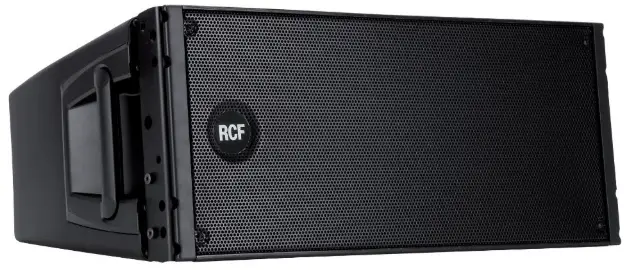
WHAKATAKITANGA ATU
- Ko nga whakatupatotanga katoa, ina koa ko nga mea haumaru, me panui me te aro nui, i te mea he korero nui.
WHAKATŪPATO: ki te aukati i te kino o te ahi, te ru hiko ranei, kaua rawa e tukuna tenei hua ki te ua, ki te makuku ranei. - TE WHAKAMAHI KAUPAPA MAI I TE MAINS
- Nga maama voltaghe nui rawa te teitei e taea ai te mate hiko; tāuta me te hono i tenei hua i mua i te whakauru ki roto.
- I mua i te whakakaha, kia mohio kua tika nga hononga katoa me te voltage o koutou matua rite ki te voltage whakaaturia ana i runga i te pereti whakatauranga i runga i te waahanga, ki te kore, whakapaa atu ki to kaihoko RCF.
- Ko tenei waahanga he hanga KARAE I, no reira me hono atu ki tetahi putanga turanga MAIN me te hononga whenua whakamarumaru.
- Appliance coupler or PowerCon Connector® is used to disconnect device from MAIN power. This device shall remain readily accessible after the installation
- Tiakina te taura hiko mai i te kino; me whakarite kia noho ki runga kia kore e taea te takahi, te kuru ranei e nga taonga.
- Hei aukati i te raru o te wiri hiko, kaua rawa e whakatuwhera i tenei hua: kaore he waahanga o roto e tika ana kia uru atu te kaiwhakamahi.
- Kia mahara kia kaua he taonga, he wai ranei e uru ki roto i tenei hua, na te mea he ara poto pea tenei.
Kaua tenei taputapu e pa ki te maturuturu, ki te pakaru ranei. Kaua nga mea kua whakakiia ki te wai, penei i nga ipu, me tuu ki runga i tenei taputapu. Kaua he puna tahanga (penei i nga rama rama) me tuu ki runga i tenei taputapu. - Kaua rawa e ngana ki te whakahaere i nga mahi, i nga whakarereketanga, i nga whakatikatika ranei kaore i te tino whakaahuatia i roto i tenei pukapuka.
Whakapa atu ki to pokapū ratonga whai mana, ki nga kaimahi whai mana ranei mena ka puta tetahi o enei e whai ake nei:- Kaore te hua e mahi (he mahi rereke ranei).
- Kua pakaru te taura hiko.
- He taonga, he wai ranei kei roto i te waahanga.
- Ko te hua kua pa ki te paanga nui.
- Mena kaore tenei hua e whakamahia mo te wa roa, momotuhia te taura hiko.
- Mena ka timata tenei hua ki te whakaputa i nga kakara rereke, i te auahi ranei, whakaweto tonu ka momotuhia te taura hiko.
- Kaua e honoa tenei hua ki nga taputapu me nga taputapu kaore i kitea.
Mo te whakaurunga kua whakatarewahia, whakamahia noa nga tohu punga kua whakatapua, kaua e ngana ki te whakairi i tenei hua ma te whakamahi i nga huānga karekau e tika ana, karekau ranei mo tenei kaupapa. Tirohia hoki te pai o te mata tautoko e mau ana te hua (te pakitara, te tuanui, te hanganga, me etahi atu), me nga waahanga e whakamahia ana mo te taapiri (nga punga o te poupou, nga wiri, nga awhi kaore i tukuna mai e te RCF me etahi atu), me whakamanahia te te haumarutanga o te punaha / whakaurunga i roto i te waa, me te whakaaro ano hoki, hei tauiraampko nga wiri miihini e mahia ana e nga kaiwhakawhitiwhiti.
Kia kore ai e taka nga taputapu, kaua e whakahiatohia nga waeine maha o tenei hua mena ka tohua tenei tupono ki te pukapuka kaiwhakamahi. - Ko te RCF SpA e tino taunaki ana kia whakauruhia tenei hua e nga kaiwhakatakoto tohu ngaio (he umanga motuhake ranei) ka taea te whakarite kia tika te whakaurunga me te whakamana kia rite ki nga ture e mana ana.
Ko te katoa o nga punaha ororongo me whai ki nga paerewa me nga ture o naianei mo nga punaha hiko. - Tautoko me nga trolleys
Me whakamahi noa nga taputapu i runga i nga taara, i nga tautoko ranei, ina tika ana, e taunakihia ana e te kaihanga. Ko te huinga taputapu/tautoko/trolley me neke me te tino tupato. Ka tu ohorere, te kaha pana me te papa koretake ka huri te huihuinga. - He maha nga ahuatanga miihini me te hiko hei whakaaro i te wa e whakauru ana i te punaha oro ngaio (i tua atu i nga mea tino oro, penei i te pehanga oro, nga koki o te kapi, te whakautu auau, me etahi atu).
- Te mate rongo
Ko te rongo ki nga taumata oro teitei ka paheke te rongo. He rereke te taumata o te pehanga oro e arai ana ki te ngaro o te rongo mai i te tangata ki te tangata, ka whakawhirinaki ki te roanga o te rongo. Hei aukati i te pa ki nga taumata teitei o te pehanga oro, me whakamahi nga taputapu whakamarumaru e tika ana mo te hunga e pa ana ki enei taumata. I te wa e whakamahia ana he kaiwhakawhiti e kaha ana ki te whakaputa i nga taumata oro teitei, na reira me mau ki nga taputapu taringa, ki nga waea whakaruru ranei. Tirohia nga whakaritenga hangarau a-ringa kia mohio ai koe ki te taumata teitei o te pehanga oro.
HE WHAKAMAHI WHAKAMAHI
Hei aukati i te haruru i runga i nga taura tohu raina, whakamahia nga taura kua oti te tirotiro anake ka karo kia tata ki:
- Ko nga taputapu e whakaputa ana i nga mara hiko hiko teitei.
- Nga taura hiko.
- Raina tukuoro.
Ko nga taputapu e whakaarohia ana i roto i tenei pukapuka ka taea te whakamahi i roto i te taiao hiko E1 ki te E3 kua tohua i runga i te EN 55103-1/2: 2009.
WHAKAMAHI WHAKAMAHI
- Whakanohia tenei hua ki tawhiti mai i nga puna wera me te whakarite kia pai te rere o te hau huri noa.
- Kaua e utaina tenei hua mo te wa roa.
- Kaua e akiaki i nga waahanga whakahaere (mau taviri, pene, me etahi atu).
- Kaua e whakamahia nga whakarewa, te waipiro, te benzene me etahi atu matū puhoi hei horoi i nga waahanga o waho o tenei hua.
HE WHAKAMAHI WHAKAMAHI
I mua i te hono me te whakamahi i tenei hua, panuihia tenei pukapuka tohutohu me te pupuri i te ringa mo te tohutoro a muri ake nei. Ko te pukapuka ka kiia he waahanga nui o tenei hua me te hono atu ina huri ana te mana rangatira hei tohutoro mo te whakaurunga tika me te whakamahi me nga tikanga tiaki. Karekau a RCF SpA e kawe i tetahi kawenga mo te whakaurunga me te / ranei te whakamahi o tenei hua.
TUpato: hei aukati i te raru o te wiri hiko, kaua e hono atu ki te toha hiko matua i te wa e tangohia ana te reihi
NGĀ TOHUTOHU MEA
- Ko te kaupapa o tenei kaikorero ahurei i ahu mai i te umanga haerenga, ka mau mai i roto i te rūnanga kiato nga wheako katoa o te tangi ngaio RCF.
- He mea maori nga oro, he maamaa te oro ki tawhiti, he pumau te mana spl ki nga taumata tiketike rawa.
- Ko nga kaiwhakawhitiwhiti RCF Precision e mau ana i te D LINE e tohu ana mo nga tekau tau mo te tino mahi, te whakahaere mana teitei me te hangarau tino matatau i roto i te umanga ngaio me te umanga haerenga.
- Ko te woofer mana teitei e tuku ana i te panguru punchy tino tika, ko te taraiwa whakakopeketanga i hangaia he tuku i te awhe waenga marama me te tino pono.
- RCF Class-D mana ampKo te hangarau lifiers e whakaemi ana i nga mahi nui e mahi ana me te tino pai ki te otinga mama. D RINA ampKa tukuna e nga kaiwhakaora te whakaeke tere tere, te whakautu tuuturu me te mahi ororongo whakamiharo.
- The integrated DSP manages crossover, equalisation , soft limiter, compressor and dynamic bass boost. D LINE cabinets are moulded on a special polypropylene composite material designed to dampen ki raro wiri ahakoa i nga tautuhinga rōrahi mōrahi.
- Mai i te hanga ki te kakano whakamutunga, ka tukuna e D LINE te tino pono me te kaha mo te whakamahi kaha i runga i te huarahi.
- Ko te HDL20-A me te HDL10-A he tino totika, he mana-whaiaro, he 2-ara nga rarangi oro puoro. Ko te 700-watt Class-D amp modules accurately match the high quality digital signal input boards with precise, complex filter responses that result in the natural, detailed reproduction of the best direct radiating designs. They are the ideal choice when line-array performance is needed but the venue size doesn’t call for the very long-throw characteristics of larger line-arrays and a fast and easy setup is a must. The speakers deliver extraordinary power handling, clarity, flexibility and great sound in a compact, easy to handle and affordable package.
THE INPUT SECTION PROVIDES:
- Tuhono XLR waho;
- IN XLR Jack paheko
- whakahaere rōrahi pūnaha;
- 5 hurihanga whirihoranga;
- 4 LED mana.
HDL20-A IS A 2-WAY ACTIVE SYSTEM FEATURING:
- 10” neo woofer, 2,5” reo pōkai i roto i te haona whirihoranga utaina;
- 2” putanga, 3” reo coil neo taraiwa kōpeketanga;
- 100° x 15°, tonu te koki kapi tika.
HDL10-A IS A 2-WAY ACTIVE SYSTEM FEATURING:
- 8” neo woofer, 2,0” reo pōkai i roto i te haona whirihoranga utaina;
- 2” putanga, 2,5” reo coil neo taraiwa kōpeketanga;
- 100° x 15°, tonu te koki kapi tika.
TE AMPLIFIER SECTION FEATURES:
- 700 Watt te whakawhiti i te kōwae hiko hiko;
- 500 Watt low frequency digital ampkōwae whakaahuru;
- 200 Watt high frequency digital ampkōwae whakaahuru;
- pahi pūnga iahiko anō ka taea te pupuri i te voltage mo te 100 ms nga tohu pakaru.
The total available power supply power is 700 Watt and can be distributed to the 2 final ampnga waahanga whakaahuru. ia amplifier section has a very high maximum output power capability in order to provide, when necessary, maximum output bursts in a specific frequency range.

NGA WHAKAMAHI KAUPAPA ME TE WHAKATAHI
The HDL line arrays Systems are designed to operate in hostile and demanding situations. Nevertheless it is important to take extremely care of the AC power supply and set up a proper power distribution. The HDL line arrays Systems are designed to be GROUNDED. Always use a grounded connection.
The HDL ampKua hoahoatia nga kaiwhakaora ki te mahi i roto i te AC Voltage rohe:
- 230 V NOMINAL VOLTAGE: iti rawa voltage 185 V, puia teiteitage 260V
- 115 V NOMINAL VOLTAGE: iti rawa voltage 95 V, puia teiteitage 132V.
Mena ko te voltage haere i raro i te iti rawa whakauru voltage ka mutu te mahi a te punaha Mena te voltage haere teitei ake i te mōrahi whakauru voltage tino kino te punaha. Ki te whiwhi i nga mahi pai mai i te punaha he mea tino nui te voltage drop it is as low as possible. Make sure that all the system is properly grounded. All the grounding points shall be connected to the same ground node. This will improve reducing hums in the audio system.
The module is provided with a Powercon outlet to daisy chain other modules. The maximum number of modules that is possible to daisy chain is:
16 (SIXTEEN) OR 4 HDL 18-AS + 8 HDL 20-A MAXIMUM OR 8 HDL18-A. 230 Volt NOMINAL VOLTAGE: iti rawa voltage 185 Volt, puia teiteitage 264 Volt (for UK 240V+10%) 115 Volt NOMINAL VOLTAGE: iti rawa voltage 95 Volt, puia teiteitage 132 Volt.
A superior number of modules in daisy chain will exceed the Powercon connector maximum ratings and create a potentially dangerous situation. When the HDL line arrays systems are powered from a three phase power distribution it is very important to keep a good balance in the load of each phase of the AC power. It is very important to include subwoofers and satellites in power distribution calculation: both subwoofers and satellites shall be distributed between the three phases.
NGA KORERO 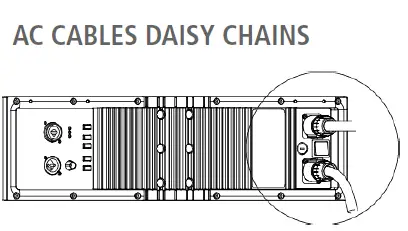
WHAKATOKANGA
TE WHAKAMAHI MAI I TE WAHA E TORU
RAWAI TUARUA

- MAIN XLR INPUT (BAL/UNBAL).The system accept male XLR/Jack input connectors with line level signals from a mixing console or other signal source.
- LINK XLR OUTPUT. The output XLR male connector provides a loop trough for speakers daisy chaining.
- ROTO. Ka whakahaere i te rōrahi o te mana ampwhakarara. Ko te mana whakahaere mai i te - (te whakahekenga teitei) ki te taumata MAX ∞ (te putanga teitei).
- WHAKAMAHI WHAKAMAHI. Tohu hiko. Ina hono te taura hiko me te whakahuri i te hiko ki runga ka kakariki tenei tohu tohu.
- WHAKAMAHI WHAKAMAHI. Ka kakariki te tohu tohu mena he tohu kei runga i te whakauru XLR matua.
- WHAKAMAHI WHAKAMAHI. Ko te ampHe ara iahiko whakawhäiti i roto i te lifier hei aukati i te tapahi o te amphe kaiwhakaora, he whakaheke ranei i nga kaiwhakawhitiwhiti. I te wa e kaha ana te ara iahiko tope tihi ka kimo karaka te LED. He pai mena ka kimo te rama rama i etahi wa. Ki te kimo tonu te rama, ki te rama tonu ranei, whakahekehia te taumata tohu. Ko te ampKei roto i te liifier he riipene RMS. Mēnā e kaha ana te whāiti RMS ka whero nga rama rama. Ko te whakawhäiti RMS te kaupapa hei aukati i nga pakaru o nga kaiwhakawhiti. Kaua rawa e whakamahia te kaikorero me te tohu tepe whero, ko te mahi tonu me te whakamarumaru RMS kaha ka pakaru te kaikorero.
- HF. The switch gives the possibility to set high frequencies correction depending on target distance (air absorption correction):
- TATA (whakamahia mo nga tono whakairi pou, papa tata ranei)
- FAR (mo te mara tino tawhiti).
- CLUSTER. The combination of the 2 switches gives 4 possibilities of mid low frequencies correction depending on cluster size.
- 2-3 modules (used for pole mount applications ground stacking)
- 4-6 kōwae (pūnaha rere iti)
- 7-9 kōwae (pūnaha rere waenga)
- 10-16 ngā kōwae (te whirihoranga rere teitei).
- HIGH CURVING. The switch gives the extra possibility to boost mid frequencies depending on a high curving cluster configuration of few pieces.
- MATUA (kaore e kaha te whakatika)
- ON (mo nga huinga kopikopiko teitei o etahi waahanga HDL20-A, HDL10-A ranei).
- INDOOR. The switch gives the extra possibility to set low frequencies correction depending on a indoor/outdoor use, in order to compensate room reverberation on lows.
- MATUA (kaore e kaha te whakatika)
- ON (whakatikanga mo nga ruma o roto e ohooho ana).
AC POWERCON RECEPTACLE. RCF D LINE uses a POWERCON locking 3-pole AC mains. Always use the specific power cord provided in the package.
- AC POWERCON LINK RECEPTACLE. Use this receptacle to link one or more units. Always make sure that the maximum current requirement does not
exceed the maximum admitted POWERCON current. In case of doubt call the closest RCF SERVICE CENTRE. - INDOOR. The switch gives the extra possibility to set low frequencies correction depending on a indoor/outdoor use, in order to compensate room reverberation on lows.
- MATUA (kaore e kaha te whakatika)
- ON (whakatikanga mo nga ruma o roto e ohooho ana).
- KAUPAPA KAUPAPA KAUPAPA. Ka huri te hiko hiko ki te ON me te OFF. Me whakarite kua tautuhia te VOLUME ki – ina whakakā koe i te kaikōrero.
- TINO.
Ka whakamahia e nga hononga XLR te paerewa AES e whai ake nei:- PIN 1 = Whenua (SHIELD)
- PIN 2 = Wera (+)
- PIN 3 = MATE (-)

I tenei wa ka taea e koe te hono i te taura hiko me te taura tohu, engari i mua i te huri i te kaikorero kia mohio kei te iti te mana o te rōrahi (ahakoa i runga i te putanga whakaranu). He mea nui kia ON kē te whakaranu i mua i te whakakā i te kaikōrero. Ma tenei ka karo i te kino o nga kaikorero me nga "pupuhi" ngangau na te huri i nga waahanga o te mekameka ororongo. He mahi pai ki te whakakā i nga kaikōrero i te mutunga ka whakaweto i muri tonu i te whakaaturanga. Inaianei ka taea e koe te ON te kaikorero me te whakatika i te mana oro ki te taumata tika.
WHAKATOKANGA: Me whakarite i nga wa katoa kia kaua e nui ake te nui o nga whakaritenga o naianei i te nui o te POWERCON o naianei kua whakaaetia. Mena kei te ruarua ka waea atu ki te RCF SERVICE CENTRE tata.
- 230 Volt, 50 Hz TATARIA: UARA FUSE T3,15A – 250V
- 115 Volt, 60 Hz WHAKATAHI: UARA FUSE T6, 30A – 250V
Audio signal can be daisy-chained using the male XLR loop through connectors. A single audio source can drive multiple speakers modules (like a full left or right channel made of 8-16 speaker modules); make sure that the source device is able to drive the impedance load made of the modules input circuits in parallel.The HDL line arrays input circuit presents a 100 KOhm input impedance. The total input impedance seen as a load from the audio source (ex. audio mixer) will be:
- impedance tāuru pūnaha = 100 KOhm / maha o iahiko whakauru i roto i te whakarara.
Ko te arai putanga e hiahiatia ana o te puna ororongo (penei i te whakaranu ororongo) ko:
- source output impedance > 10 * system input impedance;
- kia mohio tonu ko nga taura XLR hei whangai i nga tohu ororongo ki te punaha ko:
- taurite taura ororongo;
- waea i roto i te wahanga.
Ka taea e te taura ngoikore kotahi te pa ki te mahi o te punaha katoa!
Tuhinga o mua
WHAKATOKANGA
VOLTAGE TAITAI
(I RAPUIA KI TE RANGATIRATANGA RCF)
SIGNAL CABLES DAISY CHAINS
SINGLE HDL20-A, HDL10-A
The HDL is a flexible system that can be used in ground-supported or suspended applications. The following information will help you set up your HDL system safely and effectively.
When using stands or poles, be sure to observe the following precautions:
- Tirohia te tuunga pou ranei te whakatakotoranga kia mohio ai kua hangaia te taputapu hei tautoko i te taumaha o te kaikorero. Tirohia nga whakatupato ahuru katoa i whakaputahia e te kaiwhakanao.
- Be certain that the surface on which the system is to be stacked is flat, stable and solid.
- Tirotirohia te turanga (te pou me nga taputapu e pa ana) i mua i ia whakamahinga, kaua hoki e whakamahi i nga taputapu me nga waahanga kua tawhito, kua pakaru, kua ngaro ranei.
- Kaua e ngana ki te whakanoho neke atu i te rua nga kaikorero HDL ki runga i te turanga, i te poupou ranei.
- I te wa e whakairihia ana nga kaikorero HDL e rua ki runga i te pou, i te tripod ranei, me whakamahi nga taputapu rewa hei mau i nga kaikorero ki a raua ano.
- Always be cautious when deploying the system outdoors. Unexpected winds may topple a system. Avoid attaching banners or similar items to any part of a speaker system. Such attachments could act as a sail and topple the system.
A single HDL may be used on a tripod stand (AC S260) or on a pole (AC PMA) over its D LINE Series subwoofers. The use of a subwoofer is recommended for applications requiring more low-frequency power and extension and needs a pole (P.N. 13360110).
Usually, the cluster switch on the input panel should be set to the 2-3 position and the HF on NEAR when a single speaker is used. Indoor switch use depends on the speaker placement. Place the speaker on the pole or on a tripod using its own hardware LIGHT BAR HDL20-A (P.N. 13360229) or LIGHT BAR HDL10-A (P.N. 13360276) as shown in the following picture.
POLE AND TRIPOD SAFETY WARNINGS 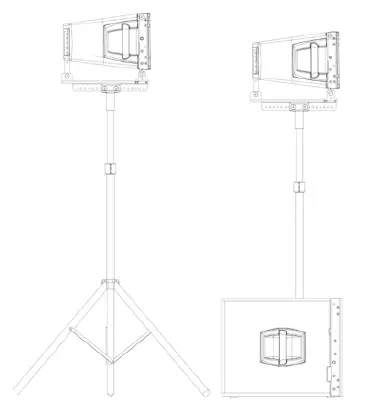
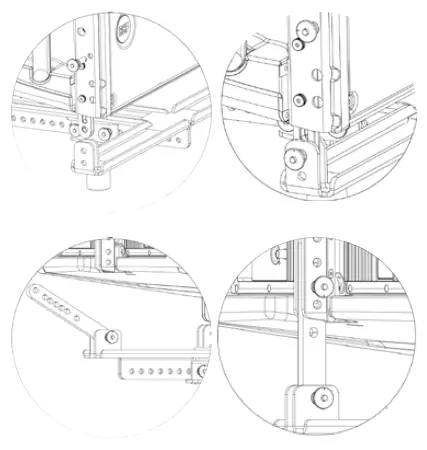
I MUA I TE WHAKATAUTANGA – TE HURU – TE tirotiro WAHA
- I te mea kua hangaia tenei hua ki runga ake i nga taonga me nga taangata, he mea nui kia whakatapua te tiaki me te aro nui ki te tirotiro i nga miihini o te hua, taputapu me nga taputapu haumaru kia mau ai te pono i te wa e whakamahia ana.
- I mua i te hiki i te Raina Raina, ata tirotirohia nga miihini katoa e uru ana ki te hiki, tae atu ki nga matau, nga titi raka tere, nga mekameka me nga punga. Me mohio kei te mau tonu, kaore he waahanga e ngaro ana, he tino mahi, kaore he tohu o te pakaru, te nui o te kakahu, te waikura ranei ka raru te haumaru i te wa e whakamahia ana.
- Manatokohia he hototahi nga taputapu katoa e tukuna ana ki te Raina Raina me te whakauru tika i runga i nga tohutohu kei roto i te pukapuka. Me mohio kei te mahi tika ratou i a raatau mahi me te kaha ki te tautoko i te taumaha o te taputapu.
- Mena kei a koe etahi feaa mo te haumarutanga o nga miihini hiki, taputapu ranei, kaua e hiki te Raina Raina me te whakapa atu ki ta maatau tari ratonga. Ko te whakamahi i tetahi taputapu kua pakaru, me nga taputapu kore e tika ka pa he whara kino ki a koe, ki etahi atu tangata ranei.
- I te wa e tirotirohia ana nga miihini me nga taputapu, me aro nui ki nga korero katoa, ka awhina tenei ki te whakarite haumaru me te kore aitua.
- I mua i te hiki i te punaha, me tirotirohia nga waahanga me nga waahanga katoa e nga kaimahi mohio me nga kaimahi mohio.
- Ko ta taatau kamupene kaore he kawenga mo te he o te whakamahi i tenei hua na te kore e tutuki ki nga tikanga tirotiro me te tiaki me etahi atu rahunga ranei.
TE tirotiro i nga miihini, nga taputapu me nga taputapu haumaru 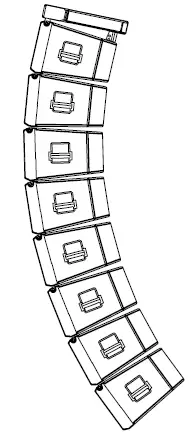
- Tirotiro kanohi nga miihini katoa ki te whakarite karekau he waahanga kua maroke, kua piko ranei, kua pakaru, kua waikura ranei.
- Tirotirohia nga kohao katoa i runga i nga miihini; tirohia kia kore e hee te ahua me te kore he kapiti, he waikura ranei.
- Tirohia nga titi cotter me nga mekameka katoa, me te whakarite kia tika te mahi; whakakapihia enei waahanga ki te kore e taea te whakauru me te raka tika ki nga waahi whakatika.
- Tirotirohia nga mekameka hiki me nga taura; tirohia kia kore he rerekee, he waikura, he pakaru ranei nga waahanga.
- Tirohia kei te mau tonu nga titi, kaore he ahua kino
- Whakamatautauria te mahi o te titi kia pai te mahi o te paatene me te puna
- Tirohia te noho mai o nga wahanga e rua; kia mohio kei te tika te tuunga me te whakahoki tika me te puta tika ina pehia te paatene ka tukuna.
TE tirotiro o nga huānga miihini me nga taputapu
TE tirohanga o nga titi raka tere
- Ko te whakatarewa i nga kawenga me tino tupato.
- I te wa e tukuna ana he punaha mau tonu nga potae tiaki me nga hu.
- Kaua rawa e tukua nga tangata kia haere i raro i te punaha i te wa o te whakaurunga.
- Kaua rawa e waiho te punaha kia kore e mataki i te wa o te whakaurunga.
- Kaua rawa e whakauruhia te punaha ki runga i nga waahi e uru ana te iwi.
- Kaua rawa e whakapiria etahi atu uta ki te punaha raupapa.
- Kaua rawa e piki i te punaha i te wa o muri ranei i te whakaurunga.
- Kaua rawa e tukuna te punaha ki etahi atu kawenga i hangaia mai i te hau me te hukarere.
WHAKATŪPATO: Me tarai te punaha i runga i nga ture me nga ture o te Whenua e whakamahia ana te punaha. Ko te kawenga o te rangatira, o te rigger ranei ki te whakarite kia tika te hangai o te punaha i runga i nga ture me nga ture o te whenua me te rohe.
WHAKATŪPATO: Tirohia i nga wa katoa ko nga waahanga katoa o te punaha rewa kaore i te whakaratohia mai i te RCF ko:
- e tika ana mo te tono;
- kua whakaaetia, kua whakamanahia, kua tohua;
- te whakatau tika;
- i roto i te ahua tino pai.
WHAKATŪPATO: Ka tautokohia e ia rūnanga te kawenga katoa o te waahanga o te punaha kei raro nei. He mea nui kia tirohia tika ia rūnanga kotahi o te punaha.
- The suspension system is designed to have a proper Safety Factors (configuration dependent). Using the “RCF Shape Designer” software it is very easy to understand safety factors and limits for each specific configuration. To better comprehend in which safety range the mechanics are working a simple introduction is needed: HDL mechanics are built with certified UNI EN 10025-95 S 235 JR and S 355 JR Steel.
- S 235 JR is a structural steel and has a stress-strain (or equivalent Force-Deformation) curve like the following.
- E rua nga tohu whakahirahira e whakaatu ana i te pihinga: ko te Ira Whati me te Ira Tukunga. Ko te ahotea tino kaha ko te taumahatanga teitei ka taea. Ko te ahotea tino kaha ka whakamahia hei tohu mo te kaha o te papanga mo te hoahoa hanganga, engari me mohio he mea nui ake etahi atu mea kaha. Ko tetahi o enei ko te kaha o te hua. Ko te hoahoa ahotea-rere o S 235 JR e whakaatu ana i te pakaru koi i te ahotea i raro i te kaha mutunga. I tenei taumahatanga nui, ka roa te roa o nga rawa kaore he huringa o te ahotea. Ko te ahotea e puta ai tenei ka kiia ko te tohu tuku.
- Ka kino pea te whakarereketanga tuturu, a, i tangohia e te ahumahi te 0.2% te riaka kirihou hei tepe noa e whakaarohia ana e nga tari whakahaere katoa. Mo te taumahatanga me te kopeketanga, ko te taumahatanga e rite ana ki tenei riaka whakawhiwhinga ka kiia ko te tukunga.
- S 355 J and S 235 JR characteristic values are R=360 [N/mm2] and R=510 [N/mm2] for Ultimate Strength and Rp0.2=235 [N/mm2] and Rp0.2=355 [N/mm2] for Yield Strength. In our prediction software the Safety Factors are calculated considering the Maximum Stress Limit equal to the Yield Strength, according with many international standards and rules. The resulting Safety Factor is the minimum of all the calculated safety factors, for each link or pin. This is where you are working with a SF=4:
Depending on local safety regulation and on situation the required safety factor can vary. It is responsibility of the owner or rigger to make sure that the system is properly rigged in accordance with Country and local laws and regulations. The “RCF Shape Designer” software gives detailed information of the safety factor for each specific configuration. The safety factor is the result of the forces acting on fly bar’s and system’s front and rear links and pins and depends on many variables:
- te maha o nga rūnanga;
WHAKATOKANGA
"RCF SHAPE DESIGNER" SOFTWARE AND HAURAI FACTOR 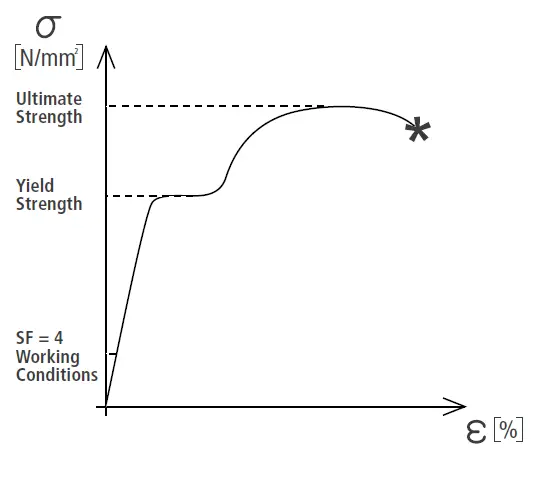

- rere koki pae;
- koki mai i nga rūnanga ki nga rūnanga. Mena ka huri tetahi o nga taurangi kua whakahuahia te take haumaru ME tatau ano ma te whakamahi i te rorohiko i mua i te rewa i te punaha.
In case the fly bar is picked up from 2 motors make sure that the fly bar angle is correct. An angle different from the angle used in the prediction software can be potentially dangerous. Never allow persons to stay or pass under the system during the installation process. When the fly bar is particularly tilted or the array is very curved the centre of gravity can move out from the rear links. In this case the front links are in compression and the rear links are supporting the total weight of the system plus the front compression. Always check very carefully with the “RCF Shape Designer” software all this kind of situations (even with a small number of cabinets).
TE TINO MAHI O NGA KAIKOORERO KA TAREIA TE WHAKAMAHI
Ko te anga HDL20-A:
- n° 16 HDL20-A;
- n° 8 HDL18-AS;
- n° 4 HDL 18-AS + 8 (WAWAW) HDL 20-A WHAKAMAHI i te Pae Hononga Apiti HDL20-HDL18-AS
TE TINO MAHI O NGA KAIKOORERO KA TAREIA TE WHAKAMAHI
Ko te anga HDL10-A:
- n° 16 HDL10-A;
- n° 8 HDL15-AS;
- n° 4 HDL 15-AS + 8 (WAWAW) HDL 10-A WHAKAMAHI i te Pae Hononga Apiti HDL10-HDL15-AS
MAXIMUM ARRAY SIZE
TE PAE RERE HDL
- AARAE RERE MUA. Tuhinga o mua.
- KAUPAPA KAUPAPA KAUPAPA KAUPAPA. Te whakapuru i mua (hei maukati i te taiapa o mua i mua i te whakaurunga).
- AITAI MUA – NGA KOPU KAUPAPA.
- NGA PICK UP POINTS.
- The pickup point is asymmetric and can be fit in two positions (A and B).
Ma te tuunga ka kawe te here ki mua.
Ko te tuunga B ka taea te hikoi takawaenga ma te whakamahi i nga rua whakatika. - Nukuhia te taiapa tiki ki te tuunga i whakaarohia e te Kaihoahoa Hanga RCF.
- Whakatikahia te awhi tiki me nga titi e rua i te taura o te taiapa hei maukati i te tiki.
TE HDL FLY BAR NGA RANGATIRA: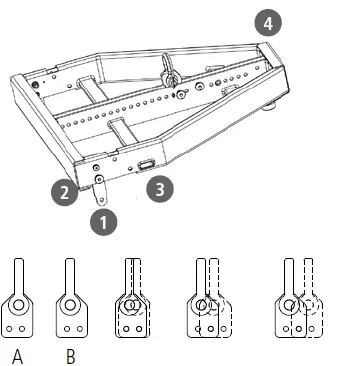
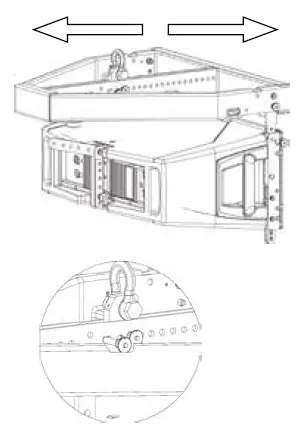 Tirohia kua mau nga titi katoa, kua maukati.
Tirohia kua mau nga titi katoa, kua maukati.
Ko te tarai i te punaha ka whai i nga tikanga:- RIGGING CHAIN HOIST.
- TE WHAKAMAHI KAUPAPA.
- PAE RERE.

TE WHAKAMAHI RIGGING
- Honoa te pae-rere F ki te kaikawe mekameka H (o nga motuka) ma te whakamahi i te maru whaimana. Whakaorangia te here.
- Connect the second pin on the front bracket to make sure that the connecting bracket is vertical.

- Honoa te taiapa o mua ki te rūnanga HD tuatahi ma te whakamahi i nga titi raka tere e 2.
TE WHAKAMAHI I TE FLY BAR HDL 20 LIGHT (PN 13360229) KA WHAKAAEA KI TE WHAKATAHI I TE MAHI O TE 4 HDL 20-A MODULE.
TE WHAKAMAHI I TE FLY BAR HDL 10 LIGHT (PN 13360276) KA WHAKAAEA KI TE WHAKATAHI I TE MAHI O TE 6 HDL 10-A MODULE.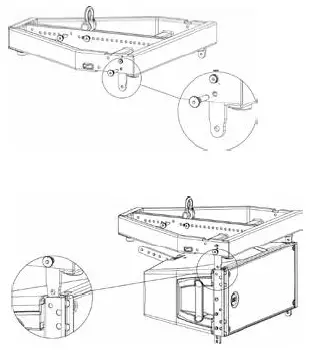

- Reverse and connect the 1 rear bracket to the fly-bar using 2 quick lock pins.
The first HDL has to be fixed always starting at 0° with respect of the frame. No other angles are allowded.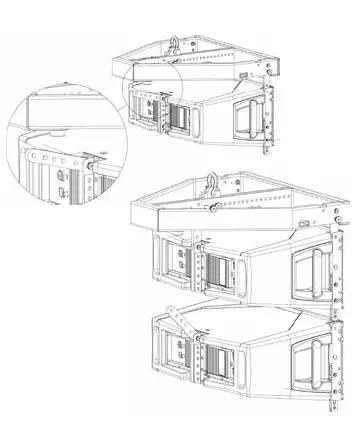
- Honoa te rūnanga tuarua ki te tuatahi ka timata mai i nga taiapa e 2 o mua.
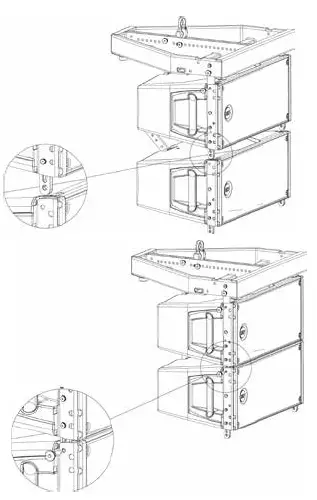
- Whakahokia ka honoa te taiapa o muri o te rūnanga tuarua ma te whakamahi i te kohao mo te koki tika.
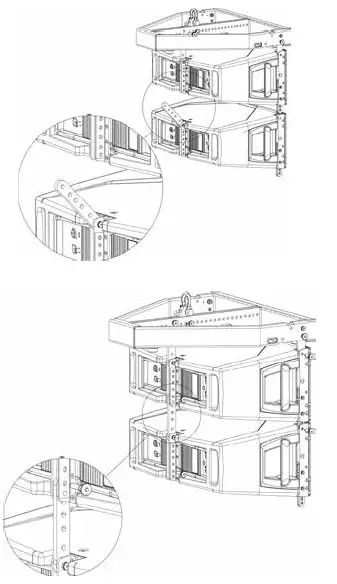
- Connect all the other cabinets following the same procedure and connecting a single cabinet each time.
TE WHAKAMAHI I TE WHAKAMAHI
HDL allow users to choose from different face-to-face angle adjustments to create arrays with varying curvature. Thus, designers can create arrays custom-tailored to each venue’s profile.
Ko te huarahi taketake ki te hoahoa huinga e whakawhirinaki ana ki nga mea e toru:
- Te maha o nga Huanga Huanga;
- Koki Maara Poutū;
- Whakapae Whakapae.
Determining the number of elements to use is critical: the number of elements greatly affects the SPL available from the system as well as the uniformity of coverage in both SPL and frequency response. The number of elements profoundly effects the directivity at lower frequencies. The next easy equation, works as an approximation for flat listening planes. Coverage (x) ≈ 8n (m) Coverage distance required = x (metres).
Ko te whakarereke i nga koki maatai i waenga i nga kaapena ka nui te paanga ki te kapi poutū mo nga iarere teitei, na te mea ko nga koki whaaiti poutū whaiti ka whakaputa i te whanuitanga poutū Q teitei ake, ka whakahekehia e te whanui whanui te Q i nga iarere teitei. I te nuinga o te waa, kaore nga koki maata e pa ki te kapi poutū i nga iarere iti.
Ka taea te whakarāpopoto i te hoahoa pūnaha huānga kōpiko:
- HDL papatahi-mua mo nga waahanga maka roa;
- whakanuia te kopiko i te mea ka heke te tawhiti;
- Tāpirihia he taapiri mo etahi atu putanga.
This approach focuses more transducers mounted on long-throw horns at the farthest seat, gradually focusing fewer transducers as distance decreases. As long as the no gap rule is maintained, arrays constructed according to these principles will provide even SPL and a consistent sonic character throughout the venue without requiring complex processing. This approach, where the same amount of acoustic energy is spread over a larger or smaller vertical angle depending on required throw, typically have the following objectives:
- tae noa ki te hipoki whakapae me te poutū;
- kākahu SPL;
- whakautu auau rite;
- SPL rawaka mo te tono.
This discussion represents, of course, just a basic approach. Given the infinite variety of venues and performers, users will find themselves needing to solve specific problems in specific situations. RCF Shape Designer software designed to help calculate optimum splay angles, aiming angles, and fly-bar pick points (crucial in aiming the array) for a given venue, will be explained later in this Guide.
PŪMANAWA KAUPAPA KAUPAPA KAUPAPA
I whakawhanakehia te rorohiko me Matlab 2015b me te hiahia ki nga wharepukapuka kaupapa Matlab. I te tuatahi o te whakaurunga me titiro te kaiwhakamahi ki te kete whakaurunga, kei te waatea mai i te RCF webpae, kei roto te Matlab Runtime (ver. 9) ranei te kete whakaurunga ka tango i te Runtime mai i te web. Once the libraries are correctly installed, for all the following version of the software the user can directly download the application without the Runtime. Two versions, 32-bit and 64-bit, are available for the download. IMPORTANT: Matlab no longer supports Windows XP and hence RCF Easy Shape Designer (32 bit) doesn’t work with this OS version.
Ka tatari pea koe mo etahi hēkona i muri i te paato-rua i te kaiwhakauru na te mea ka tirohia e te rorohiko mena kei te waatea nga Whare Pukapuka o Matlab. I muri i tenei taahiraa ka timata te whakauru. Pāwhiri-taurua i te kaitautauta whakamutunga (tirohia mo te tukunga whakamutunga i te waahanga tango o to maatau webpae) ka whai i nga mahi ka whai ake.
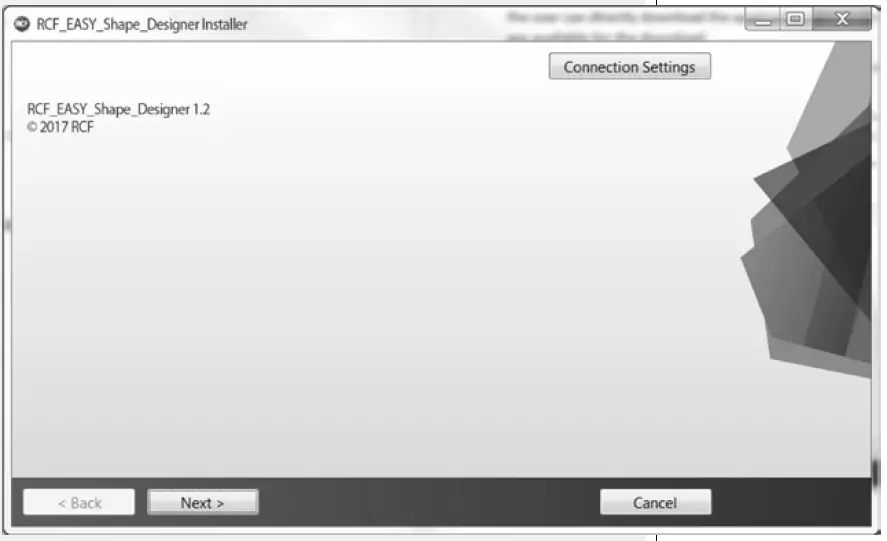
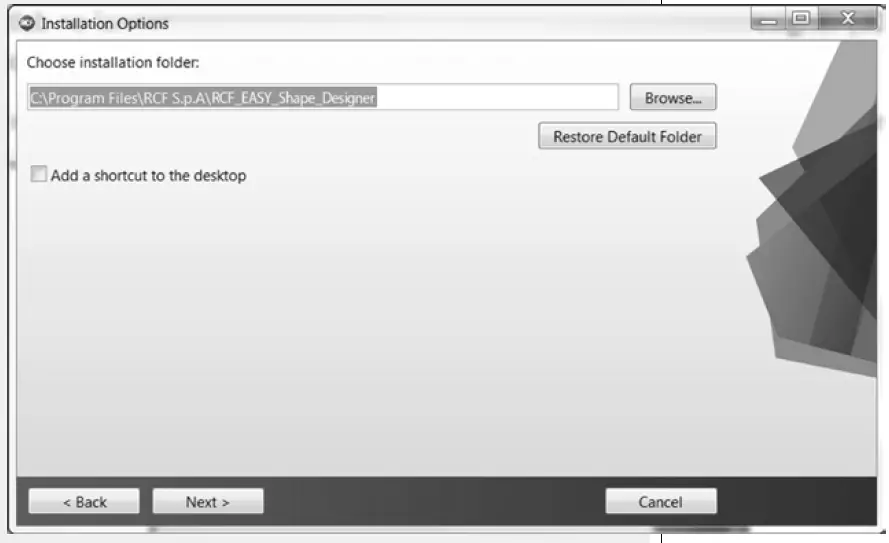
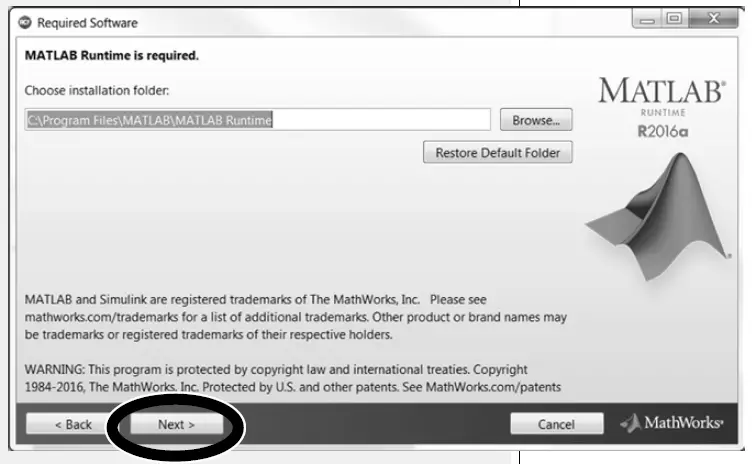

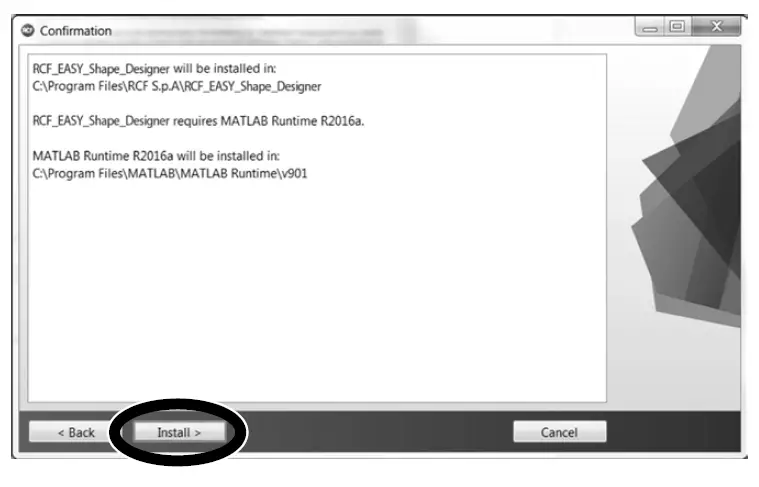
After the choice of folders for RCF Easy Shape Designer software (Figure 2) and Matlab Libraries Runtime the installer takes a couple of minutes for the installation procedure. 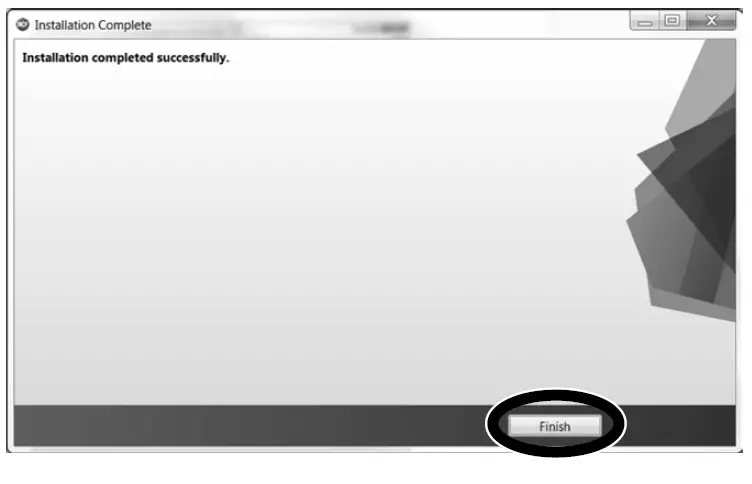
The RCF Easy Shape Designer software is divided into two macro sections: the left part of the interface is dedicated to project variables and data (size of audiences to cover, height, number of modules, etc.), the right part shows the processing results. At first the user should introduce the audience data choosing the proper pop-up menu depending on the size of the audience and introducing the geometrical data. It is also possible to define the height of the listener.
The second step is the array definition selecting the number of cabinets in the array, the hanging height, the number of hanging points and the kind of available flybars. When selecting two hanging points consider those points positioned at the flybar extremes. The height of the array should be considered referred to the bottom side of the flybar, as shown in the picture below.
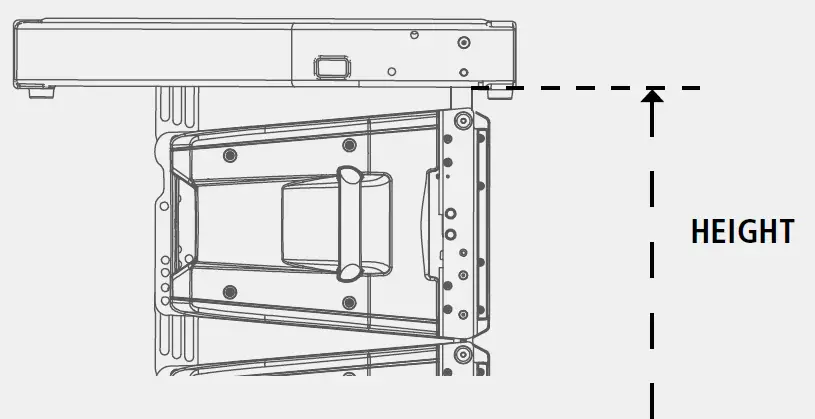
I muri i te whakauru i nga whakaurunga raraunga katoa ki te taha maui o te atanga kaiwhakamahi, ma te pehi i te paatene AUTOSPLAY ka mahi te rorohiko:
- Ko te waahi iri mo te mekameka me te tuunga A, B ranei e tohuhia ana mena ka kowhiria he waahi tiki kotahi, muri me te uta o mua mena ka kowhiria nga waahi tiki e rua.
- Ko te koki honga o te papa rererangi me nga papa o te rūnanga (he koki me whakanoho ki ia rūnanga i mua i te hikitanga).
- Ko te hiahia ka tangohia e ia rūnanga (mehemea ka kotahi te waahi tiki) me tango ranei mena ka titaha tatou i te tautau ma te whakamahi i nga miihini e rua. (e rua nga tohu tango).
- Tapeke kawenga me te Tatau Tauranga Haumaru: ki te kore te tatūnga kua tohua e hoatu te Tauwehe Haumaru> 1.5 ka whakaatu te karere kuputuhi i te tae whero te kore e tutuki i nga tikanga iti rawa o te haumaru miihini.
- Low Frequency Presets (a single preset for all the array) for RDNet use or for rear panel rotary knob use (“Local”).
- High Frequency Presets (a preset for every array module) for RDNet use or for rear panel rotary knob use (“Local”).

TE WHAKAMAHI I TE ARANGA
- Once the design (number of elements and vertical splay angles) has been designed using Shape Designer software, you can effectively optimise the array depending on the environment and the application by driving it using different DSP presets stored onboard. Typically arrays are divided in two or three zones depending the design and size of the array.
- To optimise and EQ the array, different strategies are used for high frequencies (long throws and short throws) and low frequencies.
- The longer the distance, the greater the attenuation at high frequencies. Generally, high frequencies need a correction to compensate for energy lost over distance; the correction needed is usually proportional to the distance and high-frequency air absorption. In the near- to mid-field, the air absorption is not nearly as critical; in this zone, high frequencies need little additional correction.
In the next figure is shown the equalization that corresponds to HF settings for NEAR and FAR: 
- While wave-guides provide isolated control over various mid- to high-frequency coverage areas, the low-frequency section of a HDL array still requires mutual coupling – with equal amplitude and phase – to achieve better directionality. Low-frequency directionality is less dependent on the array’s relative splay angles and more dependent on the number of elements of the array.
- At low frequencies, the more elements in the array (the longer the array), the more directional the array becomes, providing more SPL in this range. The directional control of the array is achieved when the length of the array is similar or larger than the wavelength of the frequencies being reproduced by the array.
- Although the array can (and usually should) be zoned for implementing different equalization curves for high frequencies, identical equalization should be maintained in all the low-frequency filters.
- Different low-frequency equalization settings in the same array will degrade the desired coupling effect. For the same reason, gain differences are not recommended for line arrays, since adjusting various zones with an overall amplitude control for each results in decrease of Low-frequency headroom and directionality.
- In any case, line arrays generally need a correction to compensate for energy sum on lows.
- In the next figure is shown the equalization that corresponds to CLUSTER settings, referring to different number of speakers from 2-3 up to 10-16. Increasing the number of cabinets, response curves are decreased in order to compensate the low-frequency section mutual coupling.
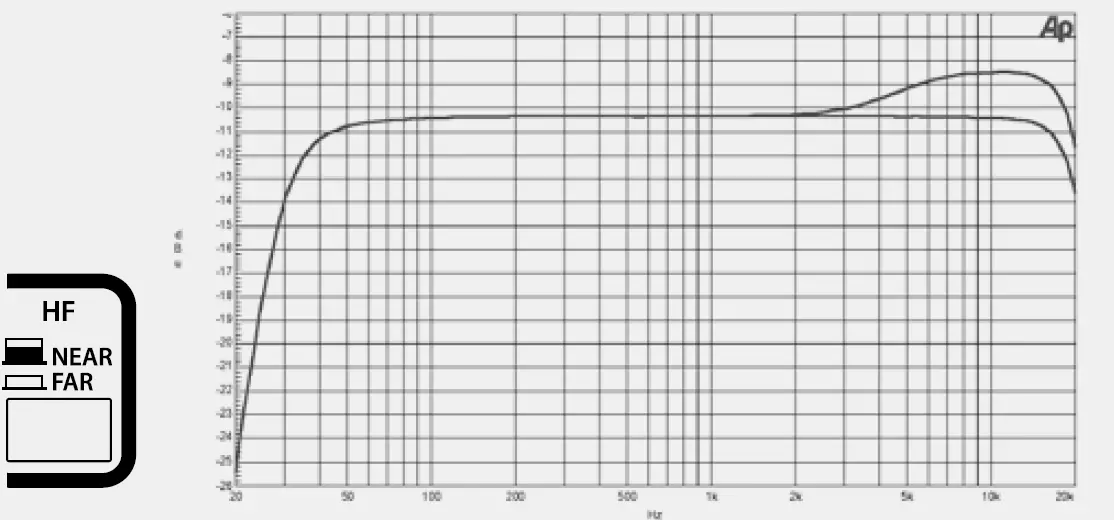
NGĀ RAUTAKI WHAKATATAUTANGA-TEIRERE
LOW-FREQUENCY COUPLING EFFECTS
HDL10-A & HDL20-A GROUND STACKED
Ka taea tonu te whakatakoto i nga waahanga HDL ki runga ake o nga riipene RCF ma te whakamahi i te pae rere HDL.
HDL 20-A Subwoofers hototahi:
- SUB 8004-AS
- SUB 8006-AS
- HDL 18-AS
HDL 10-A Subwoofers hototahi:
- SUB 8004-AS
- SUB 8006-AS
- HDL 15-AS
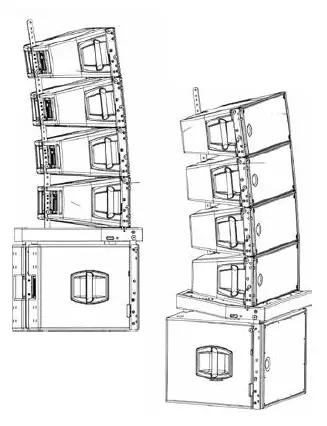
- Whakatikahia te pae rere HDL i runga i nga riipene e whakaatuhia ana i te pikitia.
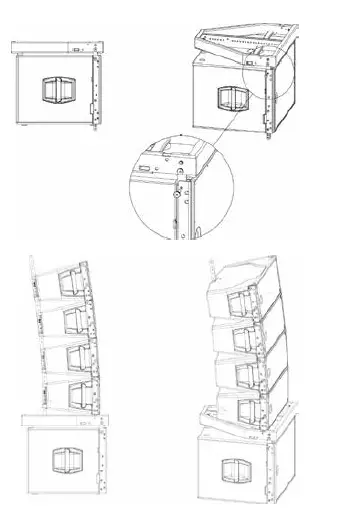
- The stacking bar adds a fixed amount of up or downtilt to ground-stacked HDL modules, with additional 15 degrees of adjustment possible (from +7,5° to -7,5°).
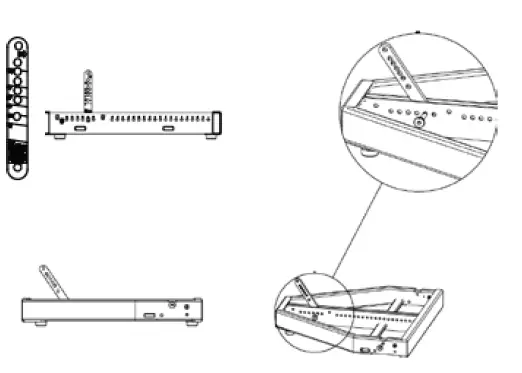
- Connect front bracket of the first HDL cabinet using 2 quick lock pins.
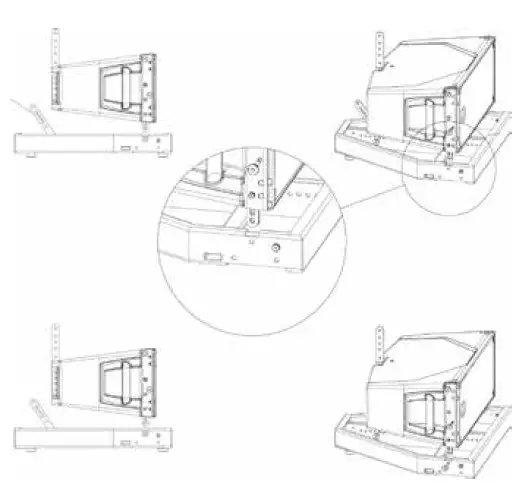
- Ko te whakaraerae o te pouaka o raro i roto i te huinga huinga e kore e tika kia whakarara ki te stage or the array frame. It can be tilted up or downward if desired. In this way arced arrays can be readily created from a ground stack position.
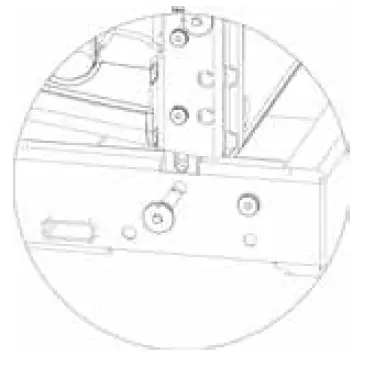
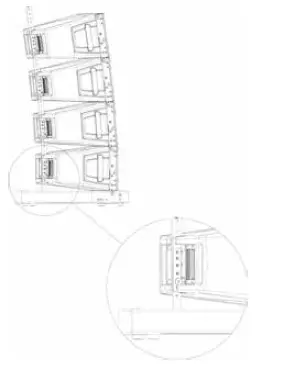
- The bottom box in a stacked array can be tilted to obtain proper coverage patterns (from+7,5° to -7,5°). Reverse and connect the 1 rear stacking bar bracket to the first enclosure using the hole for the proper angle and quick lock pins.
Add HDL cabinets one by one as indicated for flown configurations. Up to four HDL enclosures can be stacked and interlinked using the standard D LINE rigging components and the D LINE subs as ground support.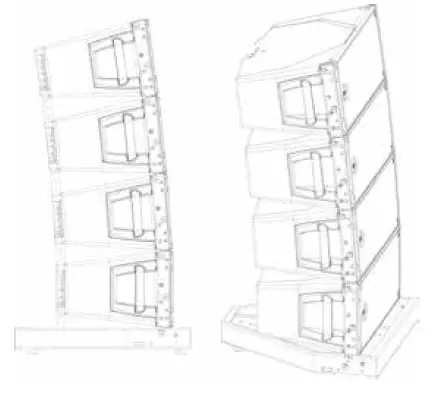
- It is possible to stack HDL speakers on the ground using its own fly bar as shown in the pictures.
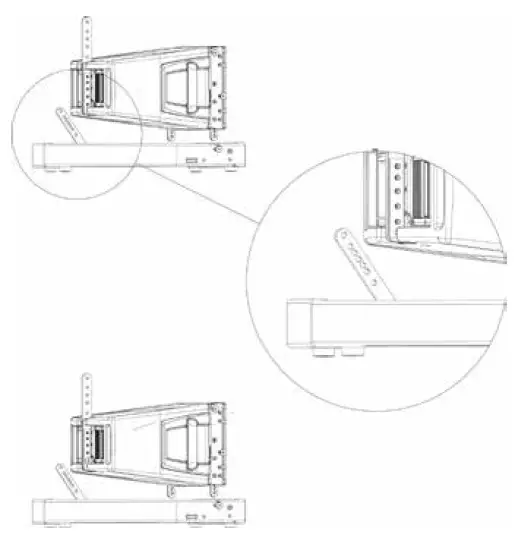
RCF SpA
Via Raffaello Sanzio, 13 42124 Reggio Emilia – Italy T
- el +39 0522 274 411
- Waeatuhi +39 0522 232 428
- ī-mēra: info@rcf.it
Pātai Auau
- Q: Ka taea e au te whakamahi i tenei hua ki waho?
A: To prevent the risk of fire or electric shock, it is advised not to expose this product to rain or humidity. - Q: What should I do if I detect strange odors coming from the product?
A: Immediately switch off the product, disconnect the power cable, and contact authorized service personnel for assistance.
Tuhinga / Rauemi
 |
RCF HDL20-A Active 2 Way Dual 10 Line Array Module [pdf] Pukapuka Tohutohu HDL20-A Active 2 Way Dual 10 Line Array Module, HDL20-A, Active 2 Way Dual 10 Line Array Module, 10 Line Array Module, Array Module |
